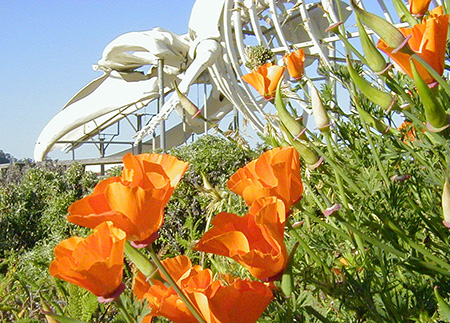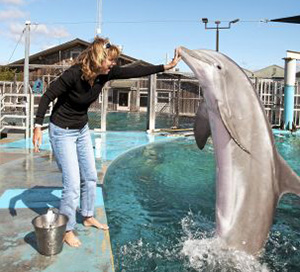The UC Santa Cruz Seymour Marine Discovery Center’s long-awaited reopening is finally on the horizon. As COVID-19 cases continue to decline in Santa Cruz County, the Seymour Center is eagerly preparing to open Seymour Center Outdoors!, a new in-person outdoor education program featuring a variety of interpretation stations run by the center’s knowledgeable docents. The stations will be located around the Pathway of Giants and will allow visitors to learn about favorite attractions like the blue whale and gray whale skeletons.
The stations are scheduled to open to the general public on April 24. The center will then remain open every Saturday, 11 a.m. to 2 p.m. (weather permitting), until further notice.
Jo Lynne Jones, a Seymour Center board member who has been helping to ensure the safety of the stations, says the format will be slightly different from pre-COVID outdoor tours to accommodate safety standards, but will remain as educational and inspiring as the tours have been in the past.
“I am looking forward to being able to have people walk through and gain knowledge from our wonderful volunteers,” Jones says. “That kind of contact with the public makes the center come alive and is the whole reason for it being there.”
The Seymour Center has also opened registration for an in-person Ocean Explorers Summer Camp for children. The program will run from June 7 to August 6 and allow campers to actively learn from field explorations, hands-on activities, games, and crafts.
Online programming continues
As the Seymour Center prepares to at least partially reopen to in-person experiences, it will also continue offering some of the unique virtual programming that has allowed it to expand its reach during the pandemic. Online experiences like Science Sundays, Labside Chats, and virtual tours of Younger Lagoon Natural Reserve have provided opportunities for the center to bring the wonders of the California coast to people who might otherwise never get to experience it.
The Seymour Center’s most recent offering, “Scientists Saving the Oceans,” was an in-depth class that allowed participants to observe researchers in action and learn from experts about marine mammals and their conservation. Jones participated in the program, and said that as eager as she is for live experiences to come back, there were also some undeniable advantages to a virtual program.
“When you are in person you are often jockeying for position to see what the guides are pointing out, but with the virtual experience, you are right there,” Jones explains. “It is very powerful.”
Structural changes
The online programming led by UC Santa Cruz scientists reflects the Seymour Center’s reimagining of the visitor experience that began before the pandemic. Based on a comprehensive review, the center has been working on new exhibits and programming to better educate the public about the role university-based research plays in conserving the world’s oceans.
UC Santa Cruz has made some structural changes to the Seymour Center that it hopes will help the center stay connected to university research. One of these changes has been to give the center a more prominent position by having it report directly to UCSC’s dean of physical and biological sciences. The university has also created a new position for a director of research initiatives for the Seymour Center and appointed Professor Terrie Williams to fill the role.
The Seymour Center hopes that providing a closer connection university researchers will allow visitors to feel connected to the ocean and the ongoing conservation efforts that university research is helping to support.
“As research scientists, my colleagues and I at UCSC have spent our lives studying nature,” Williams says. “My goal as the new director of research initiatives is to create new experiences for the young and the old to see what we have seen, both in terms of nature’s beauty and its drastic changes.”
More exciting changes on the horizon
One of the biggest changes to the Seymour Center in the past year was the retirement of its beloved founding director, Julie Barret Heffington, last June. The Seymour Center is currently searching for a new director to lead it into the next stage of its development.
As the center awaits its new director, the staff and an executive governing committee are resuming planning for facility and exhibit upgrades that had to be put on pause when the pandemic began. They are currently consulting with museum experts on how to create a new, engaging visitor experience, and they believe that the updates will help further capture the imaginations of the next generation of scientists.
“I'd like the public to know how excited we all are at the Seymour Marine Discovery Center to bring all of our friends and followers on new journeys,” Williams says. “We want visitors to be able to connect with nature in ways that they never have before. Get ready as we reopen—the expeditions begin soon!”




